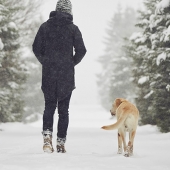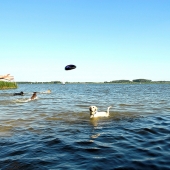Usually, yes. Cats’ incredible ability to twist their body mid-air and land on their feet when falling has baffled scientists for centuries. Through a mix of instinct, favourable physiology and physics, here’s how cats pull off this acrobatic feat.
What happens when a cat falls?
In 1894, French scientist Étienne-Jules Marey used a chronophotographic camera to film a cat’s fall, then reviewed it in slow motion to better understand their uniquely developed righting reflex.
- As soon as a cat falls, their vestibular system (located inside their inner ear) determines which way is down. The head, eyes and ears rotate to face this direction.
- The cat arches and twists their back, then positions their front feet and hind legs for the landing.
- Front paws are brought close to the face, to protect it from impact.
- If height is sufficient, a cat will stretch out their legs like a parachute to create air resistance and slow their fall.
Cats’ unique physiology
While this righting reflex isn’t exclusive to cats, their unique bone structure makes them particularly agile. Cats have free-floating clavicle bones, providing them with an increased ability to course-correct while falling. Their spine has 30 vertebrae, allowing for a greater range of motion than the human spine of 24. Their angled legs are better suited to absorb the impact when landing.
Cats’ large surface area to body weight ratio also reduces their maximum falling speed. According to a 1987 study by veterinarians Wayne Whitney and Cheryl Mehlaff, an average cat’s terminal velocity (which factors in gravity, wind resistance and weight) is 97 km per hour, while a typical adult human can reach 193 km per hour—double the impact speed.
Shorter falls may be more dangerous
The same study, which recorded the falling distance of 129 cats admitted to the Animal Medical Center in Manhattan, concluded that falling from a taller height actually improved survival rate. Cats who fell between 7 and 32 stories suffered less injury than those who fell between 2 and 6. One cat that fell 32 stories and landed on concrete suffered a chipped tooth and a mild lung puncture, and was released from the hospital after just 48 hours.
Innate talent and practice
Cats instinctively seek higher ground whether it be trees, fences or shelves. All this climbing and jumping means they’re likely to miss the mark at some point, and cats have naturally adapted to sustain minimal damage when falling. The righting reflex is seen fully developed in kittens as young as 6 or 7 weeks old, without having been taught.
Keep your cat safe from injury
While impressive, a cat’s ability to reliably land on their feet doesn’t mean they can’t suffer injury. Elderly or overweight cats may be less able to right their body while falling. A cat falling from a low to mid-rise height (such as from jumping off of a balcony or a window to catch prey) or landing on an obstacle can suffer internal injuries and require an emergency vet visit. If you live in a multi-story building, make sure all windows and doors are secure.






